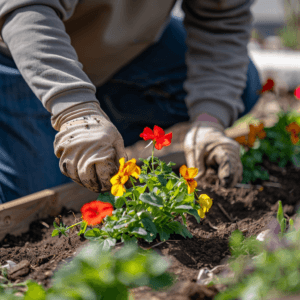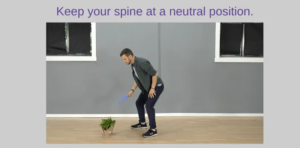It’s gardening season! For many, gardening is a rewarding hobby that is both relaxing and provides a sense of accomplishment. However, for some, back pain limits their enjoyment or prevents them from gardening altogether At Alliance Chiropractic, we understand back pain and help our patients achieve and maintain optimal back health. Our goal is to support our patients and their neuromusculoskeletal health, so they can continue enjoying their favourite activities. Whether you are an expert, avid, or beginner gardener, following these five tips can help ensure a pain-free gardening experience.
1. Bend Down with a Neutral Spine Position
When bending down to plant or weed, maintain a neutral spine position. Don’t round your back and shoulders; instead use your hips as a hinge as you lean forward. This technique keeps your spine aligned and reduces the risk of strain.
Keeping your spine neutral prevents stress on your back muscles and discs. This simple adjustment can protect you from long-term injury.
Example Exercise: Practice the hip hinge to ease back pain. You can find a helpful video here that demonstrates this technique.
2. Kneel Down on One Knee

For tasks that require you to get closer to the ground, kneel on one knee while keeping your back straight and in a neutral position. This helps maintain a neutral spine and reduces pressure on your lower back.
And remember to avoid staying in one position for too long. Changing your posture frequently prevents stiffness and discomfort.
Practical Tip: Use kneeling pads or a garden stool to make this position more comfortable. These tools provide cushioning and support, reducing strain on your knees and back.
3. Get Even Lower – Bend Over with Arm Support

Sometimes, you may need to get even lower than a kneeling position. In such cases, get on all fours and use one hand to support your weight. Ensure your spine remains neutral and avoid rounding or arching your back.
Safety Measures: Maintaining a neutral spine in this position is vital to prevent back injuries. Consider investing in ergonomic garden tools to help you stay comfortable. This article provides some useful suggestions on the types of tools to consider.
4. Keep Your Gardening Tools Close
Holding tools close to your body reduces the pressure not just on your back but also potentially on your arms, shoulders, and neck. When using heavy rakes, shovels, or other gardening tools, keep them close to your torso to minimize strain.
Tool Handling: Properly handling your tools can significantly decrease the risk of back pain. Invest in lightweight, ergonomically designed tools to make gardening easier.
5. Move your Entire Body to Avoid Twisting
Twisting while gardening can be harmful, especially if your spine is flexed. When moving dirt, plants, or tools, turn your entire body to face the object rather than twisting your spine.
Twisting motions can cause significant stress on your back, and lead to injuries.
Movement Strategy: Use garden carts or wheelbarrows to transport materials, reducing the need for twisting. This approach helps maintain proper posture and protects your back.
Other Helpful Considerations:
Gardening can be a real workout, and taking additional precautions can further help in preventing back pain. Here are some extra tips from the experts at Alliance Chiropractic and the Spine Health article:
Warm-Up Before You Start
Before diving into your gardening tasks, warm up your muscles with a brisk five-minute walk and some stretching exercises. This preparation helps your body handle the physical activity better.
Take Frequent Breaks
It’s easy to lose track of time when you love being out in the yard. Remember to take frequent breaks and hydrate yourself. If you’ve been in one position for a while, do some stretches during these breaks to avoid stiffness.
Garden While Standing
Consider wall gardening or vertical gardening to avoid bending. This method involves planting up instead of across the ground, allowing you to work at eye level and reducing strain on your back.
Container Gardening
Growing plants in containers can make gardening more manageable and reduce the need for bending and lifting. Use extra-deep containers for vegetables like tomatoes, and consider plant caddies to move heavier pots easily.
Think Outside the Box
If traditional gardening methods are too taxing, consider scaling back your garden. Focus on what’s most important and low-maintenance plants. Delegate repetitive tasks like weeding to others, or use mulch to minimize weed growth.
By incorporating these additional tips, you can further protect your back and continue to enjoy gardening without pain.
Conclusion
By incorporating these guidelines and following these tips, you can safeguard against injury and enjoy gardening without the discomfort of back pain. Help yourself to a more pleasant and pain-free gardening experience.
If you have any questions regarding this blog or any other health or wellness concern, contact Alliance Chiropractic. Our Ancaster clinic serves families across the Greater Hamilton Area, and is here to help you achieve and maintain a healthy and active lifestyle. Share your experiences and additional tips for pain-free gardening in the comments below.
Information for this blog was referenced from Back Intelligence and Spine Health.com


